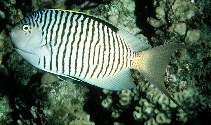| Family: |
Pomacanthidae (Angelfishes) |
| Max. size: |
20 cm TL (male/unsexed) |
| Environment: |
reef-associated; marine; depth range 2 - 70 m, non-migratory |
| Distribution: |
Western Indian Ocean: Red Sea south to Natal, South Africa (Ref. 11228), including Maldives, Madagascar, Reunion, and Mauritius (Ref. 33390). |
| Diagnosis: |
Dorsal spines (total): 15-15; Dorsal soft rays (total): 15-17; Anal spines: 3-3; Anal soft rays: 17-19. Description: Males recognized by the zebra-like stripes and black streak along the base of the dorsal fin. Females grey with black streaks along the caudal fin (Ref. 48636). Body depth 1.9-2.2 in SL. Scales longitudinal series 45-47 (Ref. 90102). |
| Biology: |
Inhabits shallow waters in the Red Sea; deeper in the Andaman Sea, usually at depths of 40 m or more. Caudal fin tips very long (Ref. 48636). A single male is usually seen with several females, commonly on steep slopes. Feeds on planktonic food several meters above the bottom. |
| IUCN Red List Status: |
Least Concern (LC); Date assessed: 08 October 2009 Ref. (130435)
|
| Threat to humans: |
harmless |
Source and more info: www.fishbase.org. For personal, classroom, and other internal use only. Not for publication.
